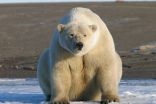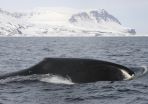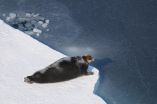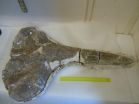(Press-News.org) For Arctic marine mammals, the future is especially uncertain. Loss of sea ice and warming temperatures are shifting already fragile Northern ecosystems.
The precarious state of those mammals is underscored in a multinational study led by a University of Washington scientist, published this week in Conservation Biology, assessing the status of all circumpolar species and subpopulations of Arctic marine mammals, including seals, whales and polar bears. The authors outline the current state of knowledge and their recommendations for the conservation of these animals over the 21st century.
"These species are not only icons of climate change, but they are indicators of ecosystem health, and key resources for humans," said lead author Kristin Laidre, a polar scientist with the UW Applied Physics Laboratory.
The overall numbers and trends due to climate change are unknown for most of the 78 populations of marine mammals included in the report: beluga, narwhal and bowhead whales; ringed, bearded, spotted, ribbon, harp and hooded seals; walruses; and polar bears.
The paper reviews population sizes and trends over time, if known, for each group, ranging from millions of ringed seals to fewer than a hundred beluga whales in Northern Canada's Ungava Bay.
"Accurate scientific data - currently lacking for many species - will be key to making informed and efficient decisions about the conservation challenges and tradeoffs in the 21st century," Laidre said.
The publicly available report also divides the Arctic Ocean into 12 regions, and calculates the changes in the dates of spring sea ice retreat and fall freeze-up from NASA satellite images taken between 1979 and 2013.
Reductions in the sea ice cover, it finds, are "profound." The summer ice period was longer in most regions by five to 10 weeks. The summer period increased by more than 20 weeks, or about five months, in the Barents Sea off Russia.
The species most at risk from the changes are polar bears and ice-associated seals.
"These animals require sea ice," Laidre said. "They need ice to find food, find mates and reproduce, to rear their young. It's their platform of life. It is very clear those species are going to feel the effects the hardest."
Whales may actually benefit from less ice cover, at least initially, as the open water could expand their feeding habitats and increase food supplies.
Approximately 78 percent of the Arctic marine mammal populations included in the study are legally harvested for subsistence across the Arctic.
"There's no other system in the world where top predators support human communities the ways these species do," Laidre said.
The study recommends:
Maintaining and improving co-management with local and governmental entities for resources that are important to the culture and well-being of local and indigenous peoples.
Recognizing variable population responses to climate change and incorporating those into management. In the long term, loss of sea ice is expected to be harmful to many Arctic marine mammals, however many populations currently exhibit variable responses.
Improving long-term monitoring while recognizing monitoring for all species will be impossible. Alternatives include collecting valuable data from subsistence harvests, using remote methods to track changes in habitat, and selecting specific subpopulations as indicators.
Studying and mitigating the impacts of increasing human activities including shipping, seismic exploration, fisheries and other resource exploration in Arctic waters.
Recognizing the limits of protected species legislation. A balanced approach with regard to regulating secondary factors, such as subsistence harvest and industrial activity, will be needed, since protected species legislation cannot regulate the driver of habitat loss.
While the report aims to bring attention to the status and future of Arctic mammals, the authors hope to provoke a broader public response.
"We may introduce conservation measures or protected species legislation, but none of those things can really address the primary driver of Arctic climate change and habitat loss for these species," Laidre said. "The only thing that can do that is the regulation of greenhouse gases."
INFORMATION:
The report was funded by the Greenland Institute of Natural Resources and NASA. Co-authors are Harry Stern at the UW; Kit Kovacs, Christian Lydersen and Dag Vongraven at the Norwegian Polar Institute; Lloyd Lowry at the University of Alaska; Sue Moore at the U.S. National Marine Fisheries Service; Eric Regehr at the U.S. Fish and Wildlife Service in Anchorage; Steven Ferguson at Fisheries and Oceans Canada; &Ostroke;ystein Wiig at the University of Oslo; Peter Boyeng and Robyn Angliss at the Alaska Fisheries Science Center; Erik Born and Fernando Ugarte at the Greenland Institute of National Resources; and Lori Quakenbush at the Alaska Department of Fish and Game.
The study builds on a 2013 report by the Conservation of Arctic Flora and Fauna, a multinational group that advises the Arctic Council on biodiversity and conservation issues. Laidre was one of the lead authors for the chapter on marine mammals.
For more information, contact Laidre at 206-616-9030 or klaidre@uw.edu. She will leave March 20 to begin fieldwork in Greenland.
The prices of leading cancer drugs have risen at rates far outstripping inflation over the last two decades, according to a new study co-authored by an MIT economist -- but the exact reasons for the cost increases are unclear.
Since 1995, a group of 58 leading cancer drugs has increased in price by 10 percent annually, even when adjusted for inflation and incremental health benefits, the study finds. More specifically, in 1995, cancer drugs in this group cost about $54,100 for each year of life they were estimated to add; by 2013, such drugs cost about $207,000 per each ...
WASHINGTON, March 17, 2015 -- Apart from their style, sunglasses have changed very little in the last few decades. Photochromic lenses that change from clear to tinted in sunlight were a big breakthrough. Now new research from ACS Applied Materials and Interfaces could give that technology a big boost. Researchers at Georgia Tech have developed a polymer coating that changes colors with the push of a button. John Reynolds, Ph.D. and his team explain these "sunglasses on demand" in the latest episode of ACS Headline Science available here: https://youtu.be/RlfOcSUpyAA.
Subscribe ...
Queen's University professor Allyson Harrison has uncovered anomalies and issues with the Wechsler Adult Intelligence Scale-Fourth Edition (WAIS-IV), one of the most widely used intelligence tests in the world. IQ scores are used to predict educational success, to help identify intellectual disabilities or intellectual giftedness and to establish whether a person has a specific learning disability.
For her research, Dr. Harrison and her colleagues examined the differences between Canadian and American WAIS-IV scores from 861 postsecondary students from across Ontario. ...
Uplift associated with the Great Rift Valley of East Africa and the environmental changes it produced have puzzled scientists for decades because the timing and starting elevation have been poorly constrained.
Now paleontologists have tapped a fossil from the most precisely dated beaked whale in the world -- and the only stranded whale ever found so far inland on the African continent -- to pinpoint for the first time a date when East Africa's mysterious elevation began.
The 17 million-year-old fossil is from the beaked Ziphiidae whale family. It was discovered 740 ...
SAN DIEGO (March 16, 2015) -- A technique used to clear blood clots from arteries to the heart in about 20 percent of patients undergoing angioplasty appears to increase the risk of stroke without providing the intended benefit, according to a study presented at the American College of Cardiology's 64th Annual Scientific Session.
The new study, which included more than 10,000 patients undergoing angioplasty in response to a severe heart attack, randomly assigned half of the patients to receive angioplasty alone and half to receive angioplasty with manual thrombectomy, ...
SAN DIEGO (March 16, 2015) -- Patients over age 80 with acute coronary syndromes would likely benefit from more invasive tests and therapies that may otherwise be denied them due to their age, according to research presented at the American College of Cardiology's 64th Annual Scientific Session in San Diego.
The study focused on treatment approaches for older patients with non ST-elevation myocardial infarction (NSTEMI, a type of heart attack that is milder in the acute phase but has a poor prognosis after six months or more) or the closely-related condition unstable ...
Patients with acute coronary syndrome undergoing angioplasty who received the anticoagulant drug bivalirudin did not show significant improvements in either of two co-primary endpoints--a composite of rate of death, heart attack or stroke at 30 days, or a composite of those events plus major bleeding--as compared to patients receiving standard anticoagulation therapy, according to a study presented at the American College of Cardiology's 64th Annual Scientific Session. However, bivalirudin was associated with significantly lower rates of bleeding complications and death, ...
SAN DIEGO (March 16, 2015) -- Patients with acute coronary syndrome undergoing coronary angiogram, a procedure used to assess blockages in the heart's arteries, had a significantly lower risk of major bleeding and death if their interventional cardiologist accessed the heart through an artery in the arm rather than the groin, according to research presented at the American College of Cardiology's 64th Annual Scientific Session. Study authors said the results should prompt a re-evaluation of clinical guidelines and that the arm, currently used in a minority of cases in the ...
A 3D printing technology developed by Silicon Valley startup, Carbon3D Inc., enables objects to rise from a liquid media continuously rather than being built layer by layer as they have been for the past 25 years, representing a fundamentally new approach to 3D printing. The technology, to appear as the cover article in the March 20 print issue of Science, allows ready-to-use products to be made 25 to 100 times faster than other methods and creates previously unachievable geometries that open opportunities for innovation not only in health care and medicine, but also in ...
Anesthetics have been used in surgical procedures for more than 150 years, but the mechanisms by which inhaled anesthesia actually work are poorly understood. Now, researchers at Johns Hopkins Medicine have discovered that anesthetics bind to and interfere with certain proteins in excitatory neurons, which are necessary for these neurons to transmit signals involved in anesthesia and the perception of pain.
"Our discovery may be an important component of the mechanism of anesthesia and -- because this particular protein is also involved in neuronal development -- could ...




